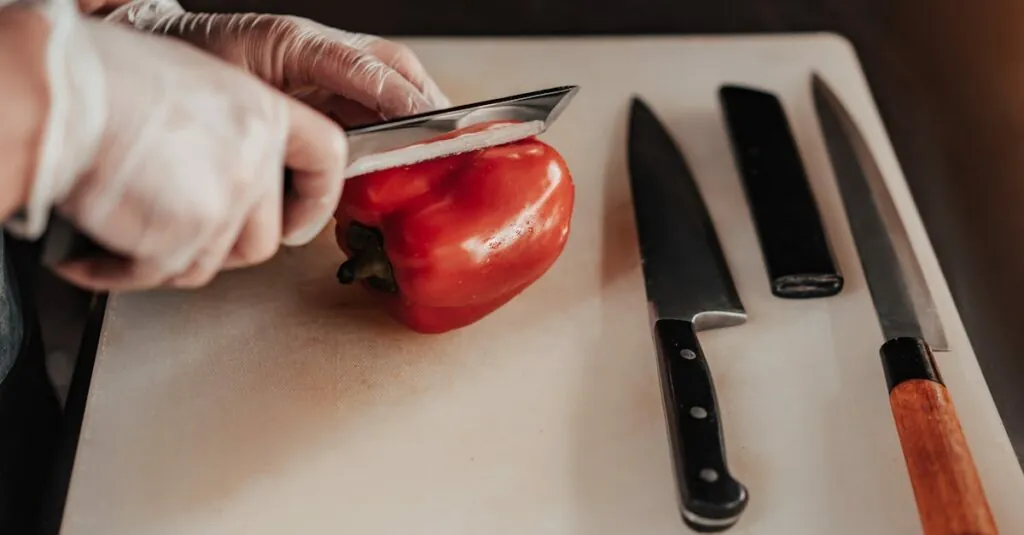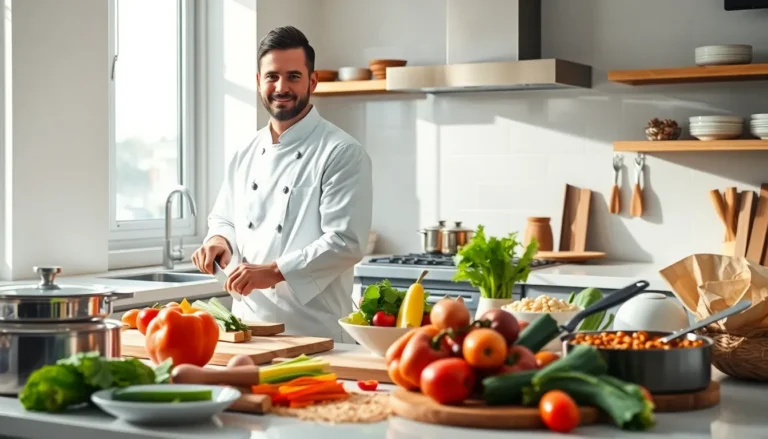Table of Contents
ToggleIn the bustling world of cooking, mastering cutting techniques is like having a secret weapon in the kitchen. Whether it’s dicing vegetables with the precision of a ninja or julienning carrots like a culinary Picasso, these skills can elevate any dish from ordinary to extraordinary. And let’s be honest, no one wants to serve a salad that looks like it was attacked by a toddler with a butter knife.
But fear not! Learning these techniques doesn’t require a culinary degree or the ability to juggle knives. With a little practice and some humor, anyone can become a chopping champion. So grab your chef’s knife and get ready to slice, dice, and impress your friends and family with your newfound skills. After all, who wouldn’t want to be the kitchen rockstar everyone talks about?
Overview Of Cutting Techniques In Cooking
Cutting techniques in cooking are essential skills that enhance a dish’s flavor and presentation. Mastering various cuts allows chefs to optimize cooking times and improve texture. Dicing, for example, involves cutting food into small uniform cubes, making it perfect for salsas or stir-fries. Julienning creates long, thin strips ideal for garnishes or salads, adding elegance to any plate.
Mincing refers to chopping food into very small, fine pieces. Garlic and herbs often benefit from this technique, releasing their flavors effectively. Slicing involves cutting food into even, flat pieces, common with meats and bread. Each technique plays a significant role in how a dish develops in taste and aesthetic appeal.
Chiffonade entails stacking, rolling, and slicing leafy greens into thin ribbons. Salads or garnishes become visually striking through this method. Skewering relies on precise cutting for uniform pieces that cook evenly on a grill, ensuring a delightful experience.
Recognizing the benefits of each technique elevates culinary skills. Consistency in cutting not only enhances the appearance but also ensures even cooking. Learning these techniques becomes more manageable with practice and dedication, making cooking more enjoyable. Adapting to various ingredients expands a chef’s repertoire and invites creativity in the kitchen. Every cut brings its unique character, transforming ordinary food into extraordinary meals.
Types Of Cutting Techniques
Cutting techniques enhance both flavor and presentation in cooking. Various methods exist, each with unique applications.
Chopping
Chopping involves cutting food into coarser pieces, making it ideal for vegetables like onions and tomatoes. Chefs often use this method for stir-fries or soups, where uniformity in size is less critical. It focuses on speed rather than precision, showing versatility in the kitchen. One skilled in chopping can quickly prepare ingredients without extensive effort. This technique allows for straightforward, quick meal preparations that do not sacrifice taste.
Mincing
Mincing entails cutting food into fine pieces, maximizing flavor extraction. Aromatics such as garlic and herbs benefit greatly from this technique, releasing essential oils that enhance dishes. A sharp knife guarantees optimal results, promoting even texture in properly minced ingredients. The size of the mince can affect the final dish significantly, impacting flavor intensity and aroma. Dishes like sauces and marinades rely on mincing for a well-rounded taste.
Dicing
Dicing refers to cutting food into uniform cubes, ensuring even cooking and consistent presentation. This technique works well with vegetables and proteins, providing texture and enhancing visual appeal. Small, medium, and large dice can cater to different culinary needs, depending on the dish’s requirements. Chefs often opt for dicing for salads and casseroles, where consistency is essential. Mastery of this technique aids in preparing ingredients that cook evenly.
Julienne
Julienne creates thin, matchstick-like strips of food, perfect for salads and garnishes. This technique showcases the ingredient’s natural colors and shapes, elevating presentation. Julienne can also help in rapid cooking, especially with vegetables like carrots and zucchini, offering swift cooking times. Consistent strips promote even cooking, essential in stir-frying. This slicing style often enhances a dish’s overall visual and textural appeal.
Brunoise
Brunoise consists of finely dicing food into tiny cubes, usually measuring 1/8-inch. This precise cut is perfect for garnishing and adding flavor without overwhelming a dish. Ingredients like vegetables or herbs undergo brunoise for an elegant finish, particularly in sophisticated presentations. It demands skill and patience, making it a hallmark of refined culinary techniques. Using brunoise improves texture and overall taste in beautifully crafted dishes.
Tools And Equipment For Cutting
Selecting the right tools enhances the cutting experience in cooking. Proper equipment ensures efficiency and safety in the kitchen.
Knives
Knives play a crucial role in any kitchen. Chefs often use chef’s knives for a variety of cutting techniques due to their versatility. A paring knife excels at intricate tasks like peeling fruit and deveining shrimp. Specialized knives like serrated knives work wonders for slicing bread and tomatoes. Keeping knives sharp is essential; dull blades can lead to accidents and uneven cuts. Proper maintenance includes honing blades regularly and using the right cutting techniques to prolong their life.
Cutting Boards
Cutting boards come in various materials, each with unique benefits. Wooden boards are gentle on knives and can add aesthetic value to kitchens. Plastic boards, however, are lightweight and dishwasher-safe, making them practical for everyday use. Bamboo boards offer a sustainable option that combines durability and eco-friendliness. Selecting the right size for tasks prevents mess and enhances efficiency. Having separate boards for meat and vegetables promotes food safety and avoids cross-contamination.
Other Essential Tools
Several essential tools complement knives and cutting boards. Mandolines provide consistent slicing for fruits and vegetables, making food prep quicker. Kitchen shears make cutting herbs and opening packages effortless. Peelers contribute to efficient peeling without waste. Additionally, measuring cups and spoons ensure precise proportions when cutting ingredients. Food processors streamline tasks and offer various attachments for different cuts, enhancing versatility in the kitchen. Having these tools readily available contributes to an organized cooking environment.
Tips For Mastering Cutting Techniques
Practice consistently to enhance cutting skills. Familiarity with knife handling builds confidence and speed in the kitchen. Start with basic techniques like chopping and dicing before progressing to more complex methods such as julienning and brunoise.
Observe the grip on the knife; a secure hold improves control and reduces the chances of accidents. Position the fingers on the food in a claw shape to protect them while using the knife. Ensure the cutting board remains stable to facilitate smooth cuts.
Maintain knife sharpness, as dull knives complicate cutting and can lead to uneven slices. Regularly hone the knife with a honing steel or sharpen it with a whetstone.
Choose the right technique based on the recipe requirements. For instance, dicing enhances the cooking process for stir-fries by providing uniform pieces. Opt for slicing when texture matters, like with vegetables for salads.
Integrate appropriate tools into the cutting process. Mandolines create even, thin slices quickly, while kitchen shears are perfect for herbs. Explore the use of various cutting boards, keeping separate boards for meats and vegetables to ensure food safety.
Engage in guided practice sessions. Watching instructional videos offers visual insight into different cutting techniques. Joining a cooking class provides hands-on experience and immediate feedback from instructors, which helps solidify skills.
By prioritizing these tips, anyone can master cutting techniques efficiently, elevating their culinary abilities and making cooking more enjoyable.
Mastering cutting techniques is key to elevating culinary skills and enhancing the overall cooking experience. By embracing the art of precise cuts and selecting the right tools, anyone can transform their kitchen endeavors into delightful creations. Each technique offers unique benefits that contribute to flavor, texture, and presentation, making meals not just enjoyable but visually appealing as well.
With consistent practice and a focus on safety and efficiency, aspiring chefs can build confidence in their abilities. Whether it’s dicing vegetables for a stir-fry or julienning herbs for a garnish, these skills empower home cooks to unleash their creativity and impress family and friends. The journey of mastering cutting techniques is both rewarding and essential for anyone looking to elevate their culinary game.



